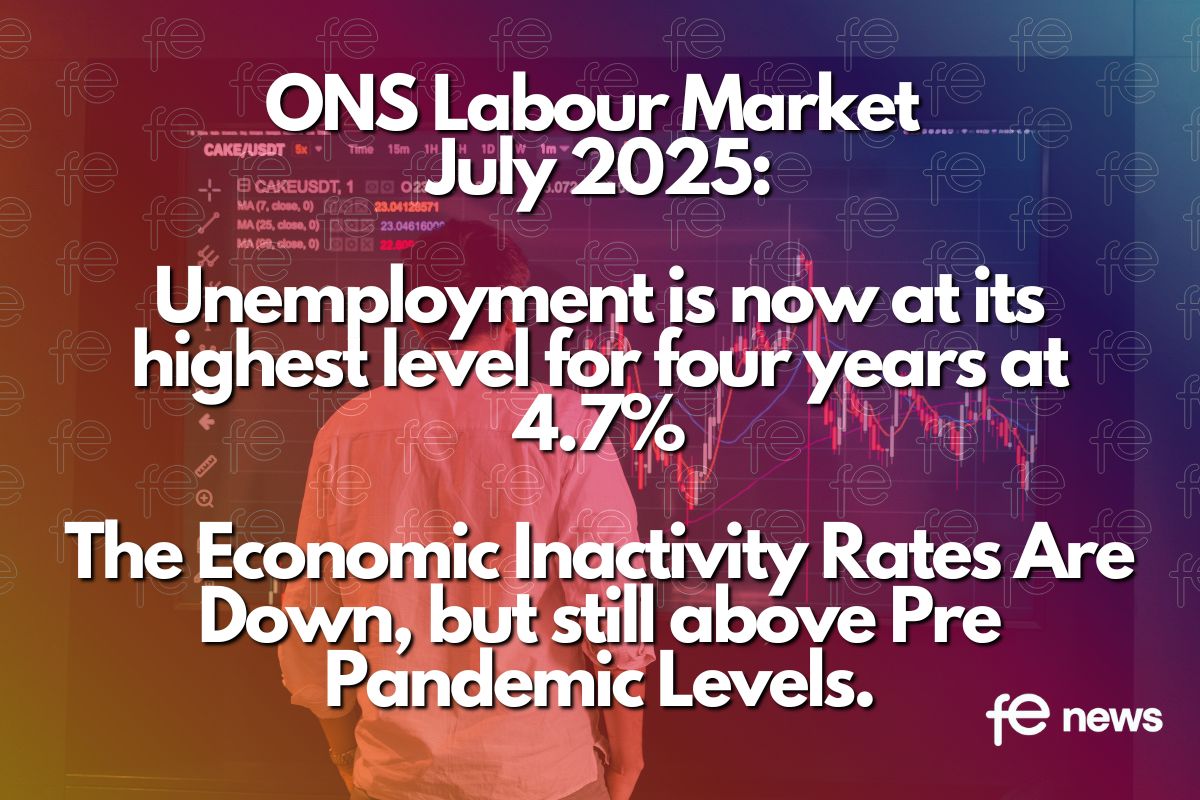August Labour Market 2023- Sector Response

“Pay growth accelerates to end 18 month wage squeeze – but 15 year stagnation has left average earnings £230 a week lower than their pre-financial crisis trend“
The UK employment rate was estimated at 75.7% in April to June 2023, 0.1 percentage points lower than January to March 2023. The quarterly decrease in employment was driven by full-time employees and self-employed workers.
The estimate of payrolled employees for July 2023 shows a monthly increase, up 97,000 on the revised June 2023 figure, to 30.2 million. The July 2023 estimate should be treated as a provisional estimate and is likely to be revised when more data are received next month.
The unemployment rate for April to June 2023 increased by 0.3 percentage points on the quarter to 4.2%. The increase in unemployment was driven by people unemployed for up to 6 months.
The economic inactivity rate decreased by 0.1 percentage points on the quarter, to 20.9% in April to June 2023. The decrease in economic inactivity during the latest quarter was largely driven by those inactive because they are looking after family or home. Meanwhile, those inactive because of long-term sickness increased to a record high.
Flows estimates show that, between January to March 2023 and April to June 2023, there was a large net movement from economic inactivity into unemployment.
In May to July 2023, the estimated number of vacancies fell by 66,000 on the quarter to 1,020,000. Vacancies fell on the quarter for the 13th consecutive period.
Annual growth in regular pay (excluding bonuses) was 7.8% in April to June 2023, this is the highest regular annual growth rate we have seen since comparable records began in 2001. Annual growth in employees’ average total pay (including bonuses) was 8.2%; this total growth rate is affected by the NHS one-off bonus payments made in June 2023. In real terms (adjusted for inflation using Consumer Prices Index including owner occupier’s housing costs (CPIH)), annual growth for total and regular pay rose on the year, by 0.5% for total pay, and by 0.1% for regular pay.
There were 160,000 working days lost because of labour disputes in June 2023. Over half of the days lost because of labour disputes in June 2023 were in the Health and Social Work sector.
Click here to read the complete labour report for August 2023.
Read last month’s Labour market and sector response by clicking here.
Resolution Foundation response:
Pay growth accelerates to end 18 month wage squeeze – but 15 year stagnation has left average earnings £230 a week lower than their pre-financial crisis trend
Real wages in June were higher than a year ago for the first time in 18 months – ending yet another painful pay squeeze across Britain. However, with unemployment rising and vacancies falling, the Bank will hope that pay rises will also start to cool in the coming months, the Resolution Foundation said today.
The latest data showed that pay growth continued to accelerate in June to 7.8 per cent across the economy, by 8.2 per cent in the private sector and 6.2 per cent in the public sector. CPIH inflation in June was 7.3 per cent.
The Foundation notes that pensioners may well be the ultimate beneficiaries of this mini pay boom – driven in part by one-off NHS bonuses – as pay growth in the three months to July will determine the size of a permanent increase in the state pension next April, if it’s higher than September’s inflation figure.
The Foundation adds that average regular pay is now slightly higher than the pre-financial crisis 2008 peak in real terms (at £613 vs £612 per week respectively) for the first time outside of the pandemic period. This unprecedented period of 15 year pay stagnation has come at a huge cost – real regular pay is £230 per week lower than if real pay growth had continued at the pre-financial crisis trend of 2.1 per cent.
The labour market continued to loosen, with vacancies falling for their 13th consecutive months to 1,020,000, and short-term unemployment rising to its highest level since Dec-Feb 2021. While much of the unemployment rise has come from falling economic inactivity rather than employment, the Bank will hope that this further labour market loosening will soon curb pay growth and ease the pressure on inflation.
The Government meanwhile will be concerned that long-term economic inactivity due to ill-health continues to hit a record high of 2.6 million – and that the employment rate among older workers (aged 50-64), which led the UK’s impressive jobs growth pre-pandemic, remains 1.5 percentage points below its 2019 peak (at 71.2 per cent).
Sector Response
Chancellor of the Exchequer Jeremy Hunt said:
“Thanks to the action we’ve taken in the jobs market, it’s great to see a record number of employees.
“Our ambitious reforms will make work pay and help even more people into work – including by expanding free childcare next year – helping to deliver on our priority to grow the economy.”
Minister for Employment, Guy Opperman MP said:
“Our jobs market continues to show its strength with employment at near record levels and inactivity down by over 300,000 since the pandemic peak. Combined with falling inflation and our package of reforms to remove barriers to work, we are on the right path to drive down household costs and grow our economy.”
Kate Shoesmith, REC Deputy Chief Executive, said:
“This is a labour market shifting to new ground and will be one the Bank of England and government will closely monitor because of the direct impact it is having on the economy. The unemployment rate is marginally above most predictions and we’re getting a sense of a loosening jobs market – where the demand for talent in certain sectors remains high, while there is a fall back in demand in other key sectors. These issues are deeply intertwined. For example, it’s particularly concerning to see the record high of economically inactive people because of long-term sickness, meanwhile, we continue to see significant problems recruiting and retaining staff in the health and care sectors. We need a fundamental rethink of the models of work in the NHS and beyond.
“The labour market remains tight enough to continue to put pressure on employers by pushing up pay, with the highest regular annual growth rate we have seen since comparable records began in 2001 – but much of this will be down to recent pay deals negotiated and is one to watch closely. Pay is important, but it is not the only thing employers should consider. Today’s workers weigh pay against the whole package, such as flexible working, training, annual leave – and even whether the corporate culture aligns to their personal values. This is why our Overcoming Shortages report last year stressed to employers the importance of working conditions and getting the offer right.
“The fact there are still over one million job vacancies calls for a better jobs matching service. This is where high quality recruiters and employability experts can make a real difference to an overstretched system. The government can then focus on greater support for people with disabilities and long-term health problems, and comprehensive care services – as these are the barriers that prevent people from getting and staying in work.
“More broadly, today’s data points to why we need a plan for economic growth and investment in the UK. A proper industrial strategy that tackles the big issues we face, and fully encompasses workforce thinking around skills, transport, access to work and immigration is long called for and urgently needed.”
Nye Cominetti, Senior Economist at the Resolution Foundation, said:
“Pay growth accelerated in June to end Britain’s painful 18-month pay squeeze.
“This welcome news for workers won’t be shared by policy makers at the Bank of England though, as it will put further pressure on their efforts to curb inflation. They will hope that rising unemployment and falling vacancies will take the steam out of pay rises in the coming months.
“The big picture however is that pay packets today are now higher than they were before the financial crisis. This unprecedented 15 year stagnation has cost average workers £230 a week – and left Britain a far poorer country.”
Jack Kennedy, Senior Economist at the global hiring and matching platform, Indeed, commented:
There are signs the cost of living could finally start to ease after record annual pay growth drove pay above inflation for the first time in over one-and-a-half years.
Regular pay growth jumped to a record 7.8% year on year in the second quarter of 2023, the highest it’s been since comparable data began in 2001. Including bonuses, the figure was 8.2% year on year, driven by one-off NHS bonuses in June.
While the wage growth figures will grab attention, the ONS data also showed the labour market continuing to rebalance. The unemployment rate jumped by a larger than expected 0.3 percentage points to 4.2%, driven by an increase in long-term unemployment and more people moving out of inactivity. However, inactivity due to long-term sickness hit a new record high.
Vacancies fell by 66,000 on the quarter to July though remain just above the million mark (1.02m), however more timely Indeed job postings data points to a further slight softening through mid-August. Yet labour demand remains comfortably above pre-pandemic levels and has only slowly been retreating from previous peaks. That could help support upward pressure on wages for a while yet as the market remains tight overall, with just 1.4 unemployed jobseeker per vacancy.
There are few signs of workers becoming more reluctant to switch jobs, as job-to-job moves jumped above 900,000 in Q2 and remain elevated compared to pre-pandemic levels. The redundancy rate ticked higher over the quarter but remains low by historical standards.
The ongoing rebalancing of the labour market means candidates no longer hold all the power and we’re seeing signs of employer behaviour starting to shift, for example around hybrid work. The share of job postings mentioning remote or hybrid terms appears to have topped out and has fallen from 16.3% to 14.6% over the past three months. That could be a sign of employers being less likely to accommodate worker preferences amid a labour market that, while still tight, is less challenging from a recruitment perspective than a few months ago.
Stephen Evans, chief executive at Learning and Work Institute, said:
“The first rise in real regular wages for 19 months, and more likely ahead as inflation falls, is unlikely to provide sufficient respite to hard-hit households. The fastest nominal wage growth on comparable records dating back to 2001 may concern the Bank of England and support the case for further interest rate rises. But more generally a fall in the employment rate, rise in unemployment and drops in vacancy levels all suggest a slowing labour market, with much of the impact of previous interest rate rises still to come.
“The bigger picture is that employment is still below pre-pandemic levels and real wages are £11,000 per year below their pre-financial crisis trend. And the pain is being felt unevenly, with people working in finance and business services seeing the fastest wage increases. We need a plan for growth that recognises that those with the least have generally been affected the most by the current economic stagnation.”
TUC General Secretary Paul Nowak said:
“The government has nothing to celebrate.
“They are presiding over the longest pay squeeze in modern history with real wages still worth less than in 2008.
“The only group of workers enjoying a serious bump in their pay are high-earners in the City. Household budgets for the vast majority of Britons remain under intense pressure.
“Meanwhile Britain’s jobs market is showing real signs of weakening with unemployment on the rise.
“We need a credible economic plan that delivers decent, well-paid jobs for everyone. The Conservatives – despite being in office for 13 years – have yet to produce one.”
Commenting on today’s zero-hours contracts figures, which showed that a record-high 1.2 million people were employed on these contracts, Paul Nowak added:
“This is a badge of shame for the Conservatives. Insecure work has reached epidemic levels under their watch.
“Zero-hours contracts should have no place in the modern labour market. They allow workers to be treated like disposable labour.
“That’s why we need stronger rights at work to give everybody dignity and respect at work.”
Ben Harrison, Director of the Work Foundation at Lancaster University, a leading think tank for improving working lives in the UK said:
“Today’s figures shows that record wage growth is being driven by finance and business services sector at 9.4%, while workers in the public sector (6.2%) and other sectors like retail (6.3%) are still seeing inflation of 7.9% wipe out any pay increases they are receiving. The cost of living crisis is far from over for the majority of workers.
“With unemployment rising by 109,000 this quarter and an increase in companies filing for insolvency, people in low paid and insecure work will be nervously looking over their shoulders – Work Foundation research shows that 42% of workers in insecure work expect to lose their jobs within the next year.
“Meanwhile economic inactivity due to long-term sickness stands at a record 2.58 million.
“We are potentially still over 12 months away from the next General Election, and action to tackle these issues can’t wait. In particular, the Government should signal now that it intends to extend cost of living support this winter, while also strengthening job security and flexibility via a new Employment Bill.”
Sandra Kerr CBE, Race Director at Business in the Community, said:
“The rate of unemployment has risen across a number of ethnic groups compared to this time last year. However, unemployment is disproportionally affecting those from Black, Asian, Mixed Race and other ethnically diverse backgrounds, with this latest update showing that they are more than twice as likely to be unemployed compared to White people.
“The gap in the unemployment rate between White people and those of a Black, Asian, Mixed Race and other ethnically diverse background has widened from 2.5 percentage points in 2020 to 3.6 percentage points. During difficult economic times, inequalities become exacerbated, and the rising number of Black, Asian, Mixed Race and other ethnically diverse not in work is a worrying trend. Employers must work to make UK workplaces inclusive and representative of the UK’s diverse population, not only to reduce inequalities but to ensure that they are tapping into this rich pool of talent.”











Responses